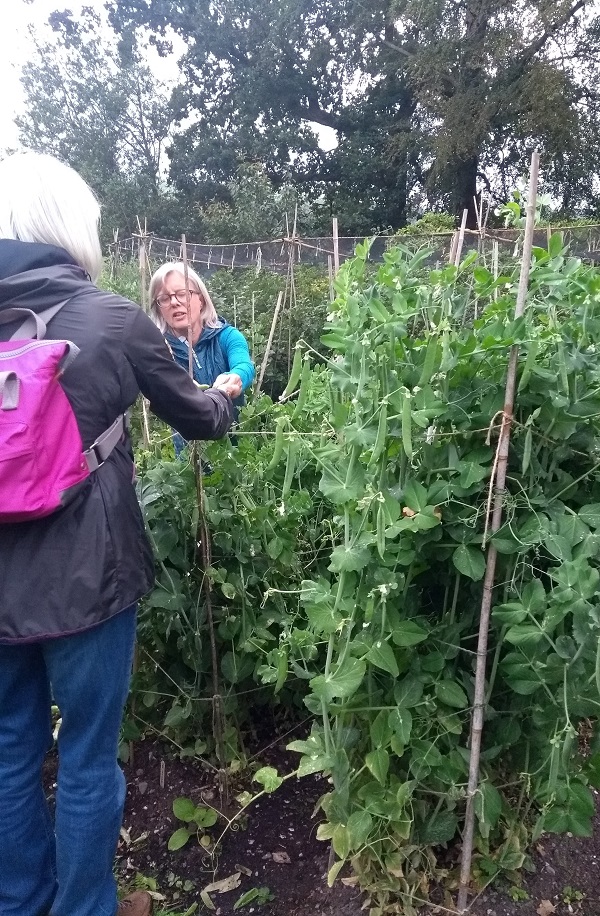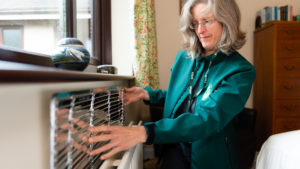In this section, we'll share tips for planning actions to reduce carbon emissions at a community level.
You’ll also see ideas for the kinds of projects you might run in your community.
Starting out
You may already have a group of individuals or an organisation wanting to tackle climate change in your community. If this is the case, the starting point could be to begin a conversation or hold a meeting with them, and to develop a simple action plan for how to engage the wider community and what early steps to take.
If there is no existing organisation or group of individuals that has already identified actions to address climate change as a priority for the community, then you could follow the example of somewhere like Ambleside. Their zero-carbon journey started with a concerned local resident holding a meeting on fracking.
The meeting was attended by a lot more people from the community than was expected and the conversation continued and turned into one about how Ambleside as a community could work to address climate change. This became Ambleside Action for a Future (AAFAF). It now has working groups, including Ambleside to Zero (A-Z). Check out the AAFAF website to see what they are doing.

Carbon footprinting – understanding what causes your community’s emissions

The first step to cutting your community’s carbon footprint is to find out what’s causing it.
You’ll be able to assume some sources of emissions, as they’re common to many communities, but your area’s exact carbon footprint will depend on whether it’s a rural area or a town, what the housing stock is like, the types businesses there are, and the availability of public transport, to name a few factors.
Your community’s carbon footprint is likely to be a combination of the emissions from households and businesses (including community and charitable organisations if they operate in the community). There will also be carbon emissions from delivery of public services and from visitors to the community. Whilst these are extremely important, it’s difficult to quantify the carbon impacts of these at a community level and to influence changes that would reduce emissions from them. Most public-sector bodies are taking active steps to reduce their own carbon emissions and it may be possible to get data from your local authority on their carbon emissions and how it relates to your community.
How to assess your community’s carbon footprint
If you are lucky enough to have some funding, then you could commission a carbon footprint of your community from an organisation that offers this service. Ambleside commissioned Small World Consulting to undertake a study of their area, as you’ll see below. The cost of this is a few hundred pounds.
Alternatively, you could take the approach that Ashton Hayes Going Carbon Neutral took in assessing their village’s carbon footprint. They worked with the University of Chester to develop a simple carbon footprint calculator for households. Students from the university went to households to help them complete the calculator and then collated all the results to develop a household carbon footprint for the village.
Households then completed the calculators each year to show how their carbon emissions had changed. The figures were collated to show how the household carbon footprint of the village overall had changed. You can learn more about how they did this at the Ashton Hayes Going Carbon Neutral website along with other information about how to get started.
If you like the approach taken in Ashton Hayes, but want to use a more up-to-date carbon footprint calculator, you don’t have to develop your own. There are many free online carbon calculators available. Here are a few:
https://calculator.carbonfootprint.com/calculator.aspx
https://www.resurgence.org/resources/carbon-calculator.html
There are some limitations in using an online carbon calculator. They are all slightly different and give different results, depending upon the questions asked and the data behind these. They also don’t provide easy ways to share the information, so it is more difficult to collate data from multiple households to arrive at a total for the community, so you would need to plan how you could do this. However, using these could provide a free means of estimating the carbon footprint of households in the community.
An example from Cumbria – emissions in Ambleside
To give you an idea of what the carbon footprint of a Cumbrian area is like, we can look at Ambleside. Research was carried out in 2019 as part of the Ambleside to Zero project to identify the different sources of emissions there. It was done by Small World Consulting, as part of a package of support from South Lakeland District Council.
It revealed an estimated carbon footprint for Ambleside of 80.7 k tonnes CO2e*. The area’s emissions were fairly evenly split between residents and industry, as you can see in the chart on the right, with residents contributing 48% and businesses 52%.
*CO2e means ‘carbon equivalents’. It takes into account other greenhouse gases as well as carbon dioxide (CO2). It signifies the amount of CO2 that would have the equivalent global warming impact for any quantity or type of greenhouse gas, such as methane.

Household emissions in Ambleside

A high-level carbon footprint for residents delved into the different activities that households undertake, and their emissions in carbon equivalents. You can see the results on the left.
Food and drink from shops makes the largest single contribution to the average Ambleside household’s carbon footprint – it’s a quarter of total household emissions.
Next comes household fuel (heat) and vehicle fuel, both at 11%, and then personal flights at 10%.
Industrial emissions in Ambleside

A carbon footprint of the different business sectors in Ambleside was also undertaken in 2019. This was more challenging, as much of the data for businesses is not available at a settlement level, so some estimates have been used.
The hospitality sector makes the largest single contribution to carbon emissions, which isn’t surprising for a community like Ambleside, with a large number of visitors.
Projects you could run in your community
As you’ll have seen in the Ambleside carbon footprint charts above, there are quite a few sources of carbon emissions. Not all of them can realistically be tackled at a community level, but here are some of the themes you could consider when planning projects:
- Food & drink
- Household electricity
- Household heating
- Community buildings
- Personal flights
- Car travel
- Reducing waste and consumption
- Community energy schemes
- Community-led housing
- Emissions from local businesses
We hope to expand our guidance on these themes in the future. For now, however, here are some ideas for projects you could run to tackle some of these sources of emissions.
Food & drink
Food and drink makes up about a quarter of the average household’s carbon footprint. It’s the biggest single chunk, so it’s an obvious place to start if you want to reduce your community’s emissions.
There are two approaches you could consider:
- Raise awareness about things people can do as individuals to reduce their food and drink carbon footprint
- Run projects that bring people together in your community
Raising awareness:
You could consider promotional campaigns and activities to encourage people to:
- Eat less meat and fewer dairy products
- Buy more locally produced food and eat what’s in season here
- Eat fewer foods that are flown here
- Grow their own food
- Waste less food
Find out more about these in our Sustainable Living Guide:
Community projects:
Community food growing is a very popular approach, bringing people together to grow food in anything from planters to a community polytunnel. The Incredible Edible movement is a great example of how this is happening in communities around the world. Visit the Incredible Edible website for more information.
We were delighted to welcome Pam Warhurst, one of the founders of Incredible Edible, to Ambleside. Pam told us the Incredible Edible story, and gave some inspiring examples of what communities are doing around the world. Watch her talk in full in the video on the right.
Household electricity

Powering our homes makes up 6% of the average UK household’s carbon footprint.
Consider projects that help people to:
- Use less electricity
- Buy electricity generated by renewable sources
Find out more about these in our advice pages:
Household heating
10% of the average UK person’s carbon footprint comes from heating their home.
Consider projects that help people to use less energy for heating, by:
- Draughtproofing
- Insulating
- Tackling damp & getting the ventilation right
- Changing to renewable sources of heating
- Buying gas and electricity (for electric heaters) generated by renewable sources
Find out more about these in our advice pages:

Other projects
Reducing waste
At a community level, one way to reduce waste and consumption is to start a local repair cafe. These are events where people bring along items that are broken and volunteers with skills do their best to fix them. There are several around Cumbria. CAfS has just produced a guide to setting up a repair cafe, with links to repair cafes in Cumbria (thanks to funding from South Lakeland District Council), and the Repair Cafe Foundation offers lots of advice and resources:
CAfS Guide to Setting Up a Repair Cafe
Visit the Repair Cafe Foundation website
Community buildings
If you have a village hall or other community venue in your area, you could explore whether it would benefit from upgrades to save energy – with the added bonus of reducing running costs. Our case study of Lowick Community Hall might give you some ideas about changes you could make and how to go about it:
CAfS Case Study – Lowick Community Hall
Community energy
There are several great examples of community energy schemes around Cumbria. Have a look at our case study comparing two Cumbrian hydro schemes in the south of the county, showing different approaches to generating clean energy, owned by the community.
A Tale of Two Hydros – Case Study
Other support
Visit the Transition Network website for ideas and resources for all sorts of grassroots projects to cut carbon emissions and increase the sustainability of your area.
Connect with sustainability groups in Cumbria
Climate emergency forum for local councils – also helpful for other community groups
Supported by South Lakeland District Council
 The community section on our website is very kindly supported by South Lakeland District Council, as part of their commitment to tackling climate change.
The community section on our website is very kindly supported by South Lakeland District Council, as part of their commitment to tackling climate change.
